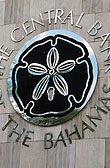| Source: Date: Updated: |
Central Bank of The Bahamas
Thursday, August 10, 2017 Thursday, August 10, 2017 |
Preliminary evidence suggests that domestic economic activity remained mildly positive during the month of June, as output in the construction sector continued to be buoyed by foreign investment projects, and to a lesser extent, public sector rebuilding activity. In contrast, the tourism sector’s performance remained soft, reflecting largely the loss of significant room inventory in one major market.
Stronger private sector demand continued to be evident, based on the year-on-year growth in foreign exchange transactions, associated with payments for imports of goods and services. The estimated fiscal deficit expanded over the first 10 months of FY2016/2017, with capital outlays leading the growth in overall expenditure, which exceeded the increase in revenue.
Monetary developments featured an expansion in banking sector liquidity, with deposit gains outpacing credit growth. External reserves firmed modestly, buoyed by inflows from real sector activity.
Tourism
The latest official data from the Ministry of Tourism for the first quarter of 2017, showed a 2.2% falloff in tourist arrivals, extending the prior year’s 0.4% softening. This outturn reflected a 9.4% decline in air traffic, a reversal from 2016’s 2.3% gain; however, the falloff in sea arrivals slowed to 0.2% from 1.1%.
In terms of the major markets, the largest decline in visitors occurred in Grand Bahama (16.6%), which lost a significant segment of its room capacity following the closure of a major resort after the passage of Hurricane Matthew. Accordingly, the island recorded a contraction in air arrivals by 41.2%, outpacing the 17.2% reduction in the prior year, while the cruise segment decreased by 12.0%, in contrast to a slight 1.4% uptick in 2016. Outcomes in the Family Islands were largely mixed, with strong gains in several islands securing an expansion in the air segment by 9.4%; however, a 13.6% decline in aggregate sea passengers, resulted in overall visitors decreasing by 11.0%, a reversal from a 2.2% increase a year ago. Conversely, total arrivals to New Providence rebounded, with growth of 7.3% relative to a 1.7% falloff in 2016. This development reflected a 14.7% improvement in sea visitors, vis-à-vis a 3.8% decrease in the prior year; however, the high value-added air component fell by 9.8%, compared to the previous year’s 3.4% improvement.
Partial indicators suggest that activity improved during the second quarter, as data from the Nassau Airport Development Company (NAD) showed a 1.9% increase in overall visitor departures by air, up slightly from the 1.5% gain registered in the second quarter of 2016. In the dominant U.S. segment, outbound passengers rose by 1.6%, compared to a 3.3% gain a year ago, while non-U.S. international departures rebounded by 4.5%, vis-à-vis a 9.5% reduction in 2016.
Construction
Construction indicators provided by the Department of Statistics for the first quarter of 2017, showed that the domestic market remained soft, with activity remaining well below its pre-recession levels. Nevertheless, during the three-month period, private residential completions rose by 4.0% in number and by 15.3% in value. Similarly, the number of permits issued for private residential construction—a forward looking indicator—firmed by 1.4% in number, but contracted by 31.1% in value, while construction starts contracted in both number and value, by 36.2% and 17.0%, respectively,
Prices
Local energy costs rose during the review period. The Bahamas Power and Light’s (BPL) fuel charge— which exerts a large influence on the housing component of the Retail Price Index—firmed by 13.7% to $15.58 per kilowatt hour (kWh) in June, month-on-month, and advanced by 66.4% over the previous year.
Fiscal Sector
Data on the Government’s budgetary operations for the first ten months of FY2016/17 revealed a $35.5 million (14.3%) expansion in the deficit to $284.7 million. This outturn reflected a $93.7 million (5.1%) rise in total expenditure to $1,938.5 million, which outpaced the $58.2 million (3.6%) increase in aggregate revenue to $1,653.8 million.
The expenditure outcome was dominated by a $92.4 million (60.4%) expansion in capital outlays to $245.4 million, amid hurricane-related gains in infrastructural spending of $66.1 million (55.1%), and asset acquisitions, of $26.3 million (79.2%). Similarly, current expenditure rose by $38.5 million (2.3%) to $1,693.0 million, due mainly to higher disbursements for purchases of goods and services, by $40.7 million (14.9%) and personal emoluments, by $22.6 million (4.1%). In a partial offset, transfer payments fell by $24.8 million (3.0%), amid a $28.5 million (4.6%) reduction in subsidies and other transfers—mainly to the Ministry of Tourism—while interest payments firmed by $3.7 million (1.7%), led by a $2.1 million (3.5%) uptick in payments to external creditors. Further, net lending to public enterprises narrowed to negligible levels, from $37.2 million in the prior year, when the Government facilitated a bridging loan for the local airline.
The expansion in aggregate revenue was led by a $52.8 million (3.7%) increase in tax receipts to $1,490.1 million. Specifically, business and professional fees rose by $18.1 million (15.7%), bolstered by a $15.7 million (19.5%) improvement in the business license component. Similarly, taxes on international trade rose by $7.8 million (1.8%), owing mainly to gains in excise and import taxes of $7.0 million (3.6%) and $4.8 million (2.1%), respectively; however, indicative of the adverse effects of the hurricane, value-added tax (VAT) receipts narrowed by $7.9 million (1.4%), relative to the same period of the previous fiscal year. In addition, other taxes firmed by $25.3 million (7.8%), as the implementation of a variety of initiatives to boost compliance rates, led to property tax collections expanding by $18.5 million (19.4%), while non-trade related stamp taxes firmed by $10.1 million (12.1%). Further, non-tax revenue rose by $5.5 million (3.5%) during the period, buoyed by gains in income and fines, forfeits & administration fees by $4.0 million (10.7%), and $1.8 million (1.5%), respectively.
For full text reading, please download the attached document.










 Download MEFD June 2017
Download MEFD June 2017
